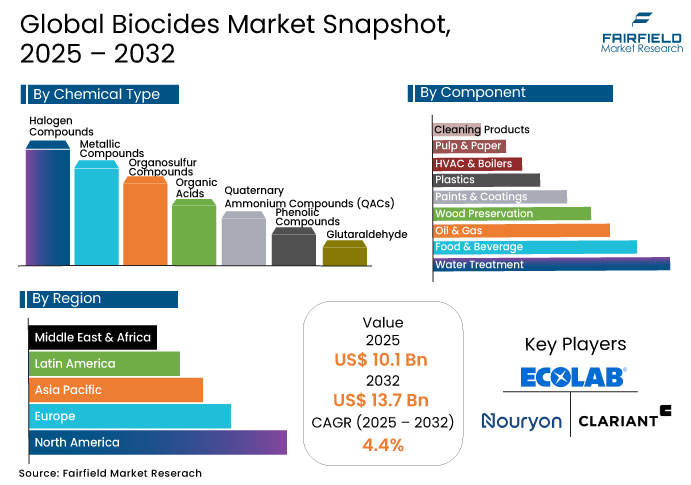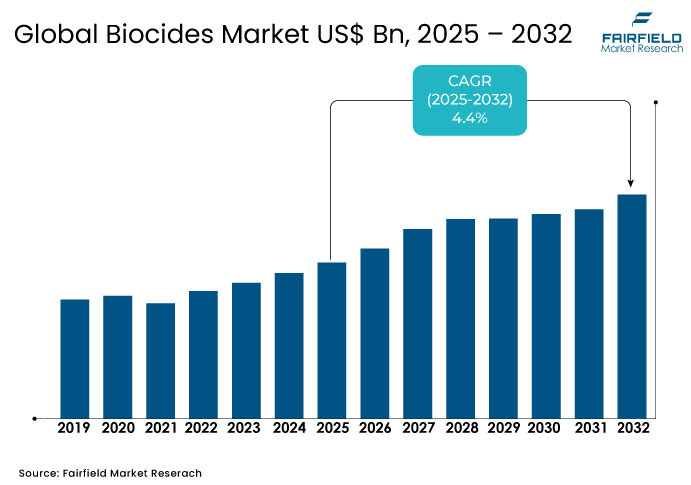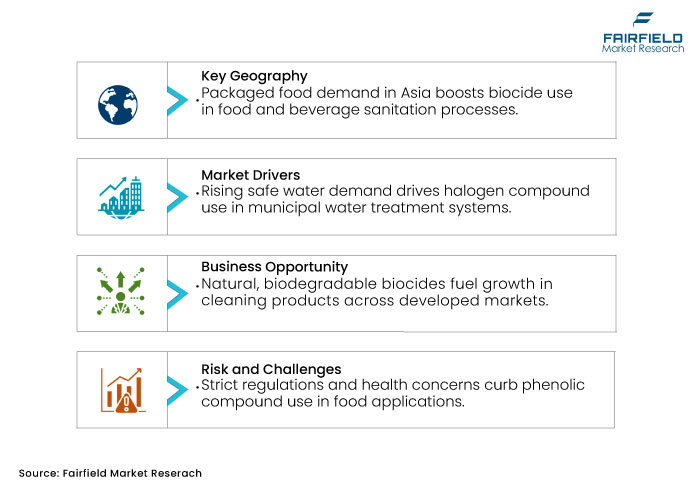Global Biocides Market Forecast
- The Global Biocides Market is expected to grow from US$10.1 Bn in 2025 to US$13.7 Bn by 2032. The market with register a steady growth rate of 4.4% during this period.
- Expanding water treatment infrastructure across industrial and municipal sectors is a key demand driver expected to significantly impact the biocides market in the coming years.

Biocides Market Insights
- Quaternary ammonium compounds are witnessing robust demand growth due to their broad-spectrum antimicrobial efficacy and regulatory approvals, especially in healthcare and institutional cleaning applications.
- Water treatment remains a major application area, driven by increasing global investments in municipal and industrial wastewater infrastructure to combat microbial contamination and ensure safe water reuse.
- In the food & beverage sector, rising consumption of packaged foods across emerging economies is accelerating the use of biocides for sanitation and surface disinfection, ensuring compliance with safety standards.
- In North America, particularly the U.S., enhanced oil recovery (EOR) initiatives are driving the demand for metallic compound-based biocides to mitigate microbial-induced corrosion in oilfield infrastructure.
A Look Back and a Look Forward- Comparative Analysis
Between 2019 and 2024, the global biocides market experienced steady growth driven by heightened hygiene awareness post-COVID-19, regulatory tightening, and increased demand from water treatment, food processing, and healthcare sectors. Manufacturers focused on antimicrobial efficacy and regulatory compliance, with significant investment in quaternary ammonium and oxidizing compounds. Supply chain disruptions briefly affected raw material availability, but demand remained resilient.
From 2025 to 2032, the market is poised for transformation with growing emphasis on eco-friendly and biodegradable biocides aligned with circular economy goals. Advancements in biotechnology and precision biocides will redefine product innovation, while emerging economies in Asia and Latin America will lead consumption growth. Regulatory harmonization, digital monitoring solutions, and sector-specific performance standards will shape competitive strategies across global players.

Key Growth Determinants
- Increasing demand for safe drinking water is boosting the use of halogen compounds in municipal water treatment applications
Increasing demand for safe drinking water is significantly boosting the adoption of halogen compounds such as chlorine and chlorine dioxide in municipal water treatment. In 2022, biocides used in water treatment generated over US$ 2 billion globally, with strong annual growth through the decade. This trend reflects the essential role halogen-based biocides play in eliminating pathogens and ensuring safe potable water for growing urban populations.
Municipal applications have emerged as a dominant consumer of halogen biocides, accounting for a major share of global consumption. Leading chemical companies like DuPont, Clariant, and Nouryon are expanding production capacity and investing in R&D for halogen-based water treatment solutions. For instance, Clariant has focused on sustainable bromine variants, while Nouryon has scaled up output in response to growing water safety needs, reinforcing this trend as a key biocides market growth driver.
Key Growth Barriers
- Stringent environmental regulations and health concerns are limiting the use of phenolic compounds in food-related applications
Highly stringent environmental regulations have increasingly restricted phenolic compounds in food-related biocide applications. Under the EU’s Biocidal Products Regulation (BPR), only approved chemicals are allowed in food contact materials, and many phenolic substances fail to meet safety and toxicology criteria. Similarly, U.S. agencies like the FDA and EPA impose tight limits on disinfectant residues in food environments, making access difficult for phenolic biocides market.
Beyond regulatory barriers, rising health concerns are further limiting phenolic usage in food processing. Research has shown that even low-level exposure to phenolic biocides can contribute to microbial resistance and reduce antibiotic efficacy, particularly in pathogens like Salmonella and Staphylococcus. In response, food manufacturers are increasingly adopting safer alternatives such as quaternary ammonium compounds, organic acids, and bio-based antimicrobials, further displacing phenolic compounds from this end-use segment.
Biocides Market Opportunities
- Rising adoption of natural and biodegradable biocides offers growth opportunities in the cleaning products segment across developed economies
The shift toward natural, biodegradable biocides market is being embraced by major manufacturers responding to eco-conscious consumer demand. For instance, Nouryon recently commissioned a production facility in the Netherlands to supply biodegradable chelates like Dissolvine® tailored for eco-friendly dishwashing and laundry products across Europe and North America. Such initiatives reflect a clear trend of sustainably sourced biocides for enhanced performance while reducing environmental impact.
This green momentum is echoed by brand-level developments. Unilever’s recent launch of Cif Infinite Clean uses probiotic bacteria to keep surfaces clean for days, targeting the large homecare market in developed regions. Meanwhile, Kalaguard SB, a sodium-benzoate-based preservative, is gaining traction in household cleaners under green-label certifications due to its biodegradable, nature-identical profile. These innovations showcase how sustainable biocide adoption is creating tangible market opportunities.

Segment-wise Overview
- Biocides are increasingly used in HVAC and boilers to prevent microbial growth, driven by expanding industrial infrastructure worldwide
Biocides market are increasingly essential in HVAC and boiler systems to prevent microbial-induced corrosion, biofilm formation, and efficiency loss. Studies indicate that biofouling in cooling water systems can reduce heat transfer efficiency by up to 30%, leading to significant operational costs and equipment wear. As industrial and commercial facilities expand globally particularly in Asia and the Middle East, the need for biocides in system maintenance becomes more critical than ever.
Moreover, the U.S. Department of Energy reports that poorly maintained HVAC systems can increase energy consumption by 20% or more, often due to microbial buildup. To counter this, companies are increasingly integrating biocidal treatments as part of preventive maintenance. Industrial facilities, data centers, hospitals, and commercial buildings in Europe and North America are setting higher indoor air quality standards, further boosting demand for biocides to ensure clean and safe air handling systems.
- Quaternary ammonium compounds are witnessing increased usage due to their broad-spectrum antimicrobial properties and regulatory approvals in healthcare
Quaternary ammonium compounds (QACs) are emerging as a dominant chemical segment in the biocides market due to their powerful, broad-spectrum antimicrobial efficacy and strong regulatory backing. The EPA reports that around 70% of its approved disinfectants contain QACs, underscoring their ubiquity in healthcare settings. Their effectiveness against bacteria, enveloped viruses (like SARS-CoV-2), and fungi makes them indispensable in clinical environments, especially during sanitation surges.
Moreover, regulatory agencies in the U.S. (FIFRA) and EU (Biocidal Products Regulation) regularly approve key QACs such as benzalkonium chloride and DDAC for use in hospitals and food processing facilities, solidifying their status as trusted, compliant antimicrobials. Increased hospital disinfection protocols, food surface sanitizers, and FDA/EPA clearances have driven wide institutional adoption. This regulatory confidence and demonstrated efficacy position QACs as a powerhouse driver behind the global biocides market’s growth.
Regional Analysis
- The U.S. is witnessing a rising demand for metallic compound-based biocides due to enhanced oil recovery initiatives in the oil & gas sector
North America, particularly the U.S., is seeing a sharp uptick in metallic compound–based biocide demand, fueled by enhanced oil recovery (EOR) growth in the oil & gas sector. Metallic biocides, such as copper- and zinc-based products, are vital to prevent microbial-induced corrosion during CO₂ flooding—a process currently responsible for approximately 4% of U.S. oil output and supported by pipelines supplying over 1.5 billion cubic feet of CO₂ per day. As EOR ramps up, maintaining microbe-free infrastructure becomes mission-critical.
Federal incentives such as the 45Q tax credit and Department of Energy funding are driving major EOR project rollouts in the Permian Basin, backed by industry leaders such as Occidental and ExxonMobil. North America already leads the global oil & gas biocides market, contributing over 50% of its revenue in recent years, signaling that metallic biocides aligned with EOR expansion are a core growth engine for the regional biocides market.

- The Europe’s push for a circular economy is accelerating demand for eco-friendly biocides in paints and coatings applications
Europe's strong push toward a circular economy, backed by the Green Deal and €3.83 billion in EU investment into 132 circular initiatives since 2019, is fueling demand for eco-friendly biocides in paints and coatings. With around 1,157 EU Ecolabel-certified paint products and 30% of UK trade-sector paints carrying this label, manufacturers are increasingly integrating biodegradable biocides to meet low-toxicity, full-lifecycle standards.
In response, major chemical players like LANXESS are showcasing sustainable biocidal additives and low-VOC preservatives tailored for circular manufacturing at international coatings expos. This integration ensures coated surfaces resist microbial degradation while remaining recyclable and non-toxic making the EU one of the fastest adopters of eco-friendly biocides within paints and coatings, and thus a key regional driver in the global biocides market.
- Rising consumer demand for packaged and processed foods in Asia is driving the use of biocides in food and beverage sanitation processes
Asia Pacific’s booming packaged and processed food sector is a major catalyst for biocide use in sanitation. In 2024, the region accounted for approximately US$130 billion in processed food and beverage sales, led by India, fueling strict hygiene protocols in food plants. High-volume production environments rely on surface-active and oxidizing biocides to prevent foodborne pathogens on machinery and contact surfaces.
Leading suppliers are expanding capacity in response. For example, Kemin Bio Solutions markets targeted biocides for dairy and meat processing lines in Asia, emphasizing shelf-life extension and microbial safety. With urbanization and rising incomes driving demand for convenience foods across China, India, and Southeast Asia, sanitation-grade biocides become indispensable in maintaining standards and scaling production, positioning this regional food-driven trend as a top growth pillar for the global biocides market.
Competitive Landscape
The competitive landscape of the global biocides market is defined by innovation, strategic partnerships, and sustainability-driven product development. Key players such as BASF, Lanxess, AkzoNobel, and Ecolab are actively investing in green chemistry, introducing low-VOC and biodegradable formulations to comply with evolving global regulations. These companies are focusing on tailored solutions for high-growth sectors like water treatment, food sanitation, and healthcare disinfection.
In addition to product innovation, market leaders are leveraging acquisitions and distribution agreements to expand their global footprint. Lanxess, for instance, acquired microbial control assets from International Flavors & Fragrances (IFF) to strengthen its biocide portfolio. Similarly, Univar Solutions’ collaboration with Arxada aimed to enhance regional market access in Latin America. These strategic moves underscore a market driven by technological differentiation and supply chain optimization.
Key Market Companies
- Ecolab Inc.
- Nuoryon
- Clariant AG
- Lubrizol Corporation
- BASF SE
- Solvay SA
- LANXESS AG
- Albemarle Corporation
- Troy Corporation
- Ashland
- DuPont de Nemours
- Chemtreat, Inc.
- Neogen Corporation
- Finoric LLC
- Shanghai Zhongxin Yuxiang Chemicals Co. Ltd.
- Hubei Jinghong Chemicals Co. Ltd.
- Wuxi Honor Shine Chemical Co. Ltd.
Expert Opinion
- Increasing regulatory scrutiny and consumer demand for sustainable formulations are pushing manufacturers to invest in bio-based and low-toxicity biocides, reshaping product portfolios and long-term R&D strategies.
- The growing complexity of industrial processes, especially in food, healthcare, and oil & gas, is driving demand for highly targeted, multi-functional biocides that offer microbial control without compromising material compatibility.
- Supply chain resilience and raw material availability are emerging as critical factors, with leading players prioritizing regional production hubs and backward integration to mitigate geopolitical and logistic disruptions.
- Future market growth will be shaped by digital integration in monitoring biocide performance, particularly in water treatment and HVAC systems, enabling predictive maintenance and improved operational efficiency.
Global Biocides Market Segmentation -
By Chemical Type
- Halogen Compounds
- Metallic Compounds
- Organosulfur Compounds
- Organic Acids
- Quaternary Ammonium Compounds (QACs)
- Phenolic Compounds
- Glutaraldehyde
- Others
By End-use
- Water Treatment
- Food & Beverage
- Oil & Gas
- Wood Preservation
- Paints & Coatings
- Plastics
- HVAC & Boilers
- Pulp & Paper
- Cleaning Products
- Miscellaneous
By Region
- North America
- Europe
- Asia Pacific
- Latin America
- Middle East & Africa
1. Executive Summary
1.1. Global Biocides Market Snapshot
1.2. Future Projections
1.3. Key Market Trends
1.4. Regional Snapshot, by Value, 2025
1.5. Analyst Recommendations
2. Market Overview
2.1. Market Definitions and Segmentations
2.2. Market Dynamics
2.2.1. Drivers
2.2.2. Restraints
2.2.3. Market Opportunities
2.3. Value Chain Analysis
2.4. COVID-19 Impact Analysis
2.5. Porter's Fiver Forces Analysis
2.6. Impact of Russia-Ukraine Conflict
2.7. PESTLE Analysis
2.8. Regulatory Analysis
2.9. Price Trend Analysis
2.9.1. Current Prices and Future Projections, 2024-2032
2.9.2. Price Impact Factors
3. Global Biocides Market Outlook, 2019 - 2032
3.1. Global Biocides Market Outlook, by Chemical Type, Value (US$ Bn) & Volume (Tons), 2019-2032
3.1.1. Halogen Compounds
3.1.2. Metallic Compounds
3.1.3. Organosulfur Compounds
3.1.4. Organic Acids
3.1.5. Quaternary Ammonium Compounds (QACs)
3.1.6. Phenolic Compounds
3.1.7. Glutaraldehyde
3.1.8. Others
3.2. Global Biocides Market Outlook, by End Use, Value (US$ Bn) & Volume (Tons), 2019-2032
3.2.1. Water Treatment
3.2.2. Food & Beverage
3.2.3. Oil & Gas
3.2.4. Wood Preservation
3.2.5. Paints & Coatings
3.2.6. Plastics
3.2.7. HVAC & Boilers
3.2.8. Pulp & Paper
3.2.9. Cleaning Products
3.2.10. Miscellaneous
3.3. Global Biocides Market Outlook, by Region, Value (US$ Bn) & Volume (Tons), 2019-2032
3.3.1. North America
3.3.2. Europe
3.3.3. Asia Pacific
3.3.4. Latin America
3.3.5. Middle East & Africa
4. North America Biocides Market Outlook, 2019 - 2032
4.1. North America Biocides Market Outlook, by Chemical Type, Value (US$ Bn) & Volume (Tons), 2019-2032
4.1.1. Halogen Compounds
4.1.2. Metallic Compounds
4.1.3. Organosulfur Compounds
4.1.4. Organic Acids
4.1.5. Quaternary Ammonium Compounds (QACs)
4.1.6. Phenolic Compounds
4.1.7. Glutaraldehyde
4.1.8. Others
4.2. North America Biocides Market Outlook, by End Use, Value (US$ Bn) & Volume (Tons), 2019-2032
4.2.1. Water Treatment
4.2.2. Food & Beverage
4.2.3. Oil & Gas
4.2.4. Wood Preservation
4.2.5. Paints & Coatings
4.2.6. Plastics
4.2.7. HVAC & Boilers
4.2.8. Pulp & Paper
4.2.9. Cleaning Products
4.2.10. Miscellaneous
4.3. North America Biocides Market Outlook, by Country, Value (US$ Bn) & Volume (Tons), 2019-2032
4.3.1. U.S. Biocides Market Outlook, by Chemical Type, 2019-2032
4.3.2. U.S. Biocides Market Outlook, by End Use, 2019-2032
4.3.3. Canada Biocides Market Outlook, by Chemical Type, 2019-2032
4.3.4. Canada Biocides Market Outlook, by End Use, 2019-2032
4.4. BPS Analysis/Market Attractiveness Analysis
5. Europe Biocides Market Outlook, 2019 - 2032
5.1. Europe Biocides Market Outlook, by Chemical Type, Value (US$ Bn) & Volume (Tons), 2019-2032
5.1.1. Halogen Compounds
5.1.2. Metallic Compounds
5.1.3. Organosulfur Compounds
5.1.4. Organic Acids
5.1.5. Quaternary Ammonium Compounds (QACs)
5.1.6. Phenolic Compounds
5.1.7. Glutaraldehyde
5.1.8. Others
5.2. Europe Biocides Market Outlook, by End Use, Value (US$ Bn) & Volume (Tons), 2019-2032
5.2.1. Water Treatment
5.2.2. Food & Beverage
5.2.3. Oil & Gas
5.2.4. Wood Preservation
5.2.5. Paints & Coatings
5.2.6. Plastics
5.2.7. HVAC & Boilers
5.2.8. Pulp & Paper
5.2.9. Cleaning Products
5.2.10. Miscellaneous
5.3. Europe Biocides Market Outlook, by Country, Value (US$ Bn) & Volume (Tons), 2019-2032
5.3.1. Germany Biocides Market Outlook, by Chemical Type, 2019-2032
5.3.2. Germany Biocides Market Outlook, by End Use, 2019-2032
5.3.3. Italy Biocides Market Outlook, by Chemical Type, 2019-2032
5.3.4. Italy Biocides Market Outlook, by End Use, 2019-2032
5.3.5. France Biocides Market Outlook, by Chemical Type, 2019-2032
5.3.6. France Biocides Market Outlook, by End Use, 2019-2032
5.3.7. U.K. Biocides Market Outlook, by Chemical Type, 2019-2032
5.3.8. U.K. Biocides Market Outlook, by End Use, 2019-2032
5.3.9. Spain Biocides Market Outlook, by Chemical Type, 2019-2032
5.3.10. Spain Biocides Market Outlook, by End Use, 2019-2032
5.3.11. Russia Biocides Market Outlook, by Chemical Type, 2019-2032
5.3.12. Russia Biocides Market Outlook, by End Use, 2019-2032
5.3.13. Rest of Europe Biocides Market Outlook, by Chemical Type, 2019-2032
5.3.14. Rest of Europe Biocides Market Outlook, by End Use, 2019-2032
5.4. BPS Analysis/Market Attractiveness Analysis
6. Asia Pacific Biocides Market Outlook, 2019 - 2032
6.1. Asia Pacific Biocides Market Outlook, by Chemical Type, Value (US$ Bn) & Volume (Tons), 2019-2032
6.1.1. Halogen Compounds
6.1.2. Metallic Compounds
6.1.3. Organosulfur Compounds
6.1.4. Organic Acids
6.1.5. Quaternary Ammonium Compounds (QACs)
6.1.6. Phenolic Compounds
6.1.7. Glutaraldehyde
6.1.8. Others
6.2. Asia Pacific Biocides Market Outlook, by End Use, Value (US$ Bn) & Volume (Tons), 2019-2032
6.2.1. Water Treatment
6.2.2. Food & Beverage
6.2.3. Oil & Gas
6.2.4. Wood Preservation
6.2.5. Paints & Coatings
6.2.6. Plastics
6.2.7. HVAC & Boilers
6.2.8. Pulp & Paper
6.2.9. Cleaning Products
6.2.10. Miscellaneous
6.3. Asia Pacific Biocides Market Outlook, by Country, Value (US$ Bn) & Volume (Tons), 2019-2032
6.3.1. China Biocides Market Outlook, by Chemical Type, 2019-2032
6.3.2. China Biocides Market Outlook, by End Use, 2019-2032
6.3.3. Japan Biocides Market Outlook, by Chemical Type, 2019-2032
6.3.4. Japan Biocides Market Outlook, by End Use, 2019-2032
6.3.5. South Korea Biocides Market Outlook, by Chemical Type, 2019-2032
6.3.6. South Korea Biocides Market Outlook, by End Use, 2019-2032
6.3.7. India Biocides Market Outlook, by Chemical Type, 2019-2032
6.3.8. India Biocides Market Outlook, by End Use, 2019-2032
6.3.9. Southeast Asia Biocides Market Outlook, by Chemical Type, 2019-2032
6.3.10. Southeast Asia Biocides Market Outlook, by End Use, 2019-2032
6.3.11. Rest of SAO Biocides Market Outlook, by Chemical Type, 2019-2032
6.3.12. Rest of SAO Biocides Market Outlook, by End Use, 2019-2032
6.4. BPS Analysis/Market Attractiveness Analysis
7. Latin America Biocides Market Outlook, 2019 - 2032
7.1. Latin America Biocides Market Outlook, by Chemical Type, Value (US$ Bn) & Volume (Tons), 2019-2032
7.1.1. Halogen Compounds
7.1.2. Metallic Compounds
7.1.3. Organosulfur Compounds
7.1.4. Organic Acids
7.1.5. Quaternary Ammonium Compounds (QACs)
7.1.6. Phenolic Compounds
7.1.7. Glutaraldehyde
7.1.8. Others
7.2. Latin America Biocides Market Outlook, by End Use, Value (US$ Bn) & Volume (Tons), 2019-2032
7.2.1. Water Treatment
7.2.2. Food & Beverage
7.2.3. Oil & Gas
7.2.4. Wood Preservation
7.2.5. Paints & Coatings
7.2.6. Plastics
7.2.7. HVAC & Boilers
7.2.8. Pulp & Paper
7.2.9. Cleaning Products
7.2.10. Miscellaneous
7.3. Latin America Biocides Market Outlook, by Country, Value (US$ Bn) & Volume (Tons), 2019-2032
7.3.1. Brazil Biocides Market Outlook, by Chemical Type, 2019-2032
7.3.2. Brazil Biocides Market Outlook, by End Use, 2019-2032
7.3.3. Mexico Biocides Market Outlook, by Chemical Type, 2019-2032
7.3.4. Mexico Biocides Market Outlook, by End Use, 2019-2032
7.3.5. Argentina Biocides Market Outlook, by Chemical Type, 2019-2032
7.3.6. Argentina Biocides Market Outlook, by End Use, 2019-2032
7.3.7. Rest of LATAM Biocides Market Outlook, by Chemical Type, 2019-2032
7.3.8. Rest of LATAM Biocides Market Outlook, by End Use, 2019-2032
7.4. BPS Analysis/Market Attractiveness Analysis
8. Middle East & Africa Biocides Market Outlook, 2019 - 2032
8.1. Middle East & Africa Biocides Market Outlook, by Chemical Type, Value (US$ Bn) & Volume (Tons), 2019-2032
8.1.1. Halogen Compounds
8.1.2. Metallic Compounds
8.1.3. Organosulfur Compounds
8.1.4. Organic Acids
8.1.5. Quaternary Ammonium Compounds (QACs)
8.1.6. Phenolic Compounds
8.1.7. Glutaraldehyde
8.1.8. Others
8.2. Middle East & Africa Biocides Market Outlook, by End Use, Value (US$ Bn) & Volume (Tons), 2019-2032
8.2.1. Water Treatment
8.2.2. Food & Beverage
8.2.3. Oil & Gas
8.2.4. Wood Preservation
8.2.5. Paints & Coatings
8.2.6. Plastics
8.2.7. HVAC & Boilers
8.2.8. Pulp & Paper
8.2.9. Cleaning Products
8.2.10. Miscellaneous
8.3. Middle East & Africa Biocides Market Outlook, by Country, Value (US$ Bn) & Volume (Tons), 2019-2032
8.3.1. GCC Biocides Market Outlook, by Chemical Type, 2019-2032
8.3.2. GCC Biocides Market Outlook, by End Use, 2019-2032
8.3.3. South Africa Biocides Market Outlook, by Chemical Type, 2019-2032
8.3.4. South Africa Biocides Market Outlook, by End Use, 2019-2032
8.3.5. Egypt Biocides Market Outlook, by Chemical Type, 2019-2032
8.3.6. Egypt Biocides Market Outlook, by End Use, 2019-2032
8.3.7. Nigeria Biocides Market Outlook, by Chemical Type, 2019-2032
8.3.8. Nigeria Biocides Market Outlook, by End Use, 2019-2032
8.3.9. Rest of Middle East Biocides Market Outlook, by Chemical Type, 2019-2032
8.3.10. Rest of Middle East Biocides Market Outlook, by End Use, 2019-2032
8.4. BPS Analysis/Market Attractiveness Analysis
9. Competitive Landscape
9.1. Company Vs Segment Heatmap
9.2. Company Market Share Analysis, 2024
9.3. Competitive Dashboard
9.4. Company Profiles
9.4.1. Ecolab Inc.
9.4.1.1. Company Overview
9.4.1.2. Product Portfolio
9.4.1.3. Financial Overview
9.4.1.4. Business Strategies and Developments
9.4.2. Nuoryon
9.4.2.1. Company Overview
9.4.2.2. Product Portfolio
9.4.2.3. Financial Overview
9.4.2.4. Business Strategies and Developments
9.4.3. Clariant AG
9.4.3.1. Company Overview
9.4.3.2. Product Portfolio
9.4.3.3. Financial Overview
9.4.3.4. Business Strategies and Developments
9.4.4. Lubrizol Corporation
9.4.4.1. Company Overview
9.4.4.2. Product Portfolio
9.4.4.3. Financial Overview
9.4.4.4. Business Strategies and Developments
9.4.5. BASF SE
9.4.5.1. Company Overview
9.4.5.2. Product Portfolio
9.4.5.3. Financial Overview
9.4.5.4. Business Strategies and Developments
9.4.6. Solvay SA
9.4.6.1. Company Overview
9.4.6.2. Product Portfolio
9.4.6.3. Financial Overview
9.4.6.4. Business Strategies and Developments
9.4.7. LANXESS AG
9.4.7.1. Company Overview
9.4.7.2. Product Portfolio
9.4.7.3. Financial Overview
9.4.7.4. Business Strategies and Developments
9.4.8. Albemarle Corporation
9.4.8.1. Company Overview
9.4.8.2. Product Portfolio
9.4.8.3. Financial Overview
9.4.8.4. Business Strategies and Developments
9.4.9. Troy Corporation
9.4.9.1. Company Overview
9.4.9.2. Product Portfolio
9.4.9.3. Financial Overview
9.4.9.4. Business Strategies and Developments
9.4.10. Ashland
9.4.10.1. Company Overview
9.4.10.2. Product Portfolio
9.4.10.3. Financial Overview
9.4.10.4. Business Strategies and Developments
9.4.11. DuPont de Nemours
9.4.11.1. Company Overview
9.4.11.2. Product Portfolio
9.4.11.3. Financial Overview
9.4.11.4. Business Strategies and Developments
9.4.12. Chemtreat, Inc.
9.4.12.1. Company Overview
9.4.12.2. Product Portfolio
9.4.12.3. Financial Overview
9.4.12.4. Business Strategies and Developments
9.4.13. Neogen Corporation
9.4.13.1. Company Overview
9.4.13.2. Product Portfolio
9.4.13.3. Financial Overview
9.4.13.4. Business Strategies and Developments
9.4.14. Finoric LLC
9.4.14.1. Company Overview
9.4.14.2. Product Portfolio
9.4.14.3. Financial Overview
9.4.14.4. Business Strategies and Developments
9.4.15. Shanghai Zhongxin Yuxiang Chemicals Co. Ltd.
9.4.15.1. Company Overview
9.4.15.2. Product Portfolio
9.4.15.3. Financial Overview
9.4.15.4. Business Strategies and Developments
10. Appendix
10.1. Research Methodology
10.2. Report Assumptions
10.3. Acronyms and Abbreviations
|
BASE YEAR |
HISTORICAL DATA |
FORECAST PERIOD |
UNITS |
|||
|
2024 |
|
2019 - 2024 |
2025 - 2032 |
Value: US$ Billion |
||
|
REPORT FEATURES |
DETAILS |
|
Chemical Type Coverage |
|
|
End Use Coverage |
|
|
Geographical Coverage |
|
|
Leading Companies |
|
|
Report Highlights |
Key Market Indicators, Macro-micro economic impact analysis, Technological Roadmap, Key Trends, Driver, Restraints, and Future Opportunities & Revenue Pockets, Porter’s 5 Forces Analysis, Historical Trend (2019-2024), Market Estimates and Forecast, Market Dynamics, Industry Trends, Competition Landscape, Category, Region, Country-wise Trends & Analysis, COVID-19 Impact Analysis (Demand and Supply Chain) |
